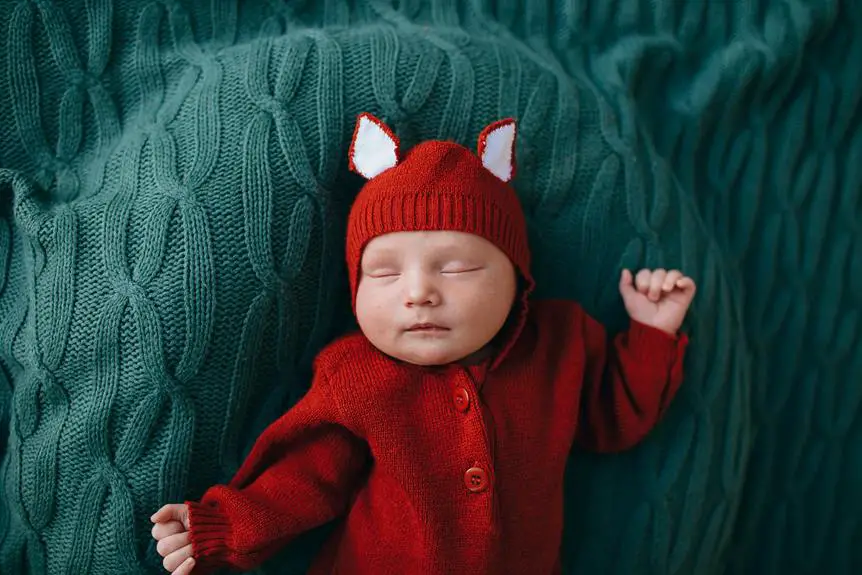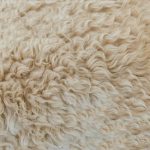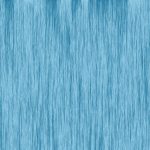When considering fabric options for baby clothes, you might find yourself questioning whether Dotted Swiss is a suitable choice. With its lightweight and breathable qualities, it seems to align perfectly with what's needed for delicate infant skin. However, while the charming patterns and soft texture can be visually appealing, there are a few important factors to weigh before making a final decision. Are the benefits worth it, or could there be potential downsides? Let's explore what makes this fabric unique and if it truly lives up to its reputation for baby apparel.
Table of Contents
What Is Dotted Swiss?
Dotted Swiss is a lightweight, sheer fabric known for its characteristic raised dots, making it a popular choice for creating charming baby clothes.
This fabric typically features a cotton, polyester, or a blend of fibers, giving it a soft feel against delicate skin.
You'll often find it in pastel colors and whimsical patterns, perfect for little ones.
When you consider Dotted Swiss for baby clothes, you're looking at a fabric that provides breathability and comfort, essential for infants who tend to get warm easily.
This sheer quality adds a delicate touch to outfits without compromising on durability, ensuring that the clothing lasts through countless washes and wears.
You may also appreciate how easy it's to work with Dotted Swiss when sewing.
It drapes well and holds its shape, making it adaptable for various styles, from dresses to bonnets.
Benefits for Baby Clothing
Choosing Dotted Swiss for baby clothing offers numerous benefits that enhance both comfort and style for your little one.
This lightweight fabric is soft and gentle against your baby's sensitive skin, reducing the chances of irritation during wear. Its breathable nature helps regulate temperature, allowing your baby to feel comfortable whether it's warm or cool.
Dotted Swiss also comes in various colors and designs, adding a charming touch to your baby's wardrobe. The tiny dots give an elegant look while still being playful, making it suitable for different occasions—from everyday wear to special events.
Plus, its durability ensures that the items can withstand frequent washing, making it a practical choice for busy parents.
When you choose Dotted Swiss, you're not just opting for a visually appealing fabric; you're also selecting something that supports your baby's comfort and freedom of movement.
The fabric drapes beautifully, allowing for a variety of styles, from dresses to rompers. With Dotted Swiss, you'll have peace of mind knowing your baby isn't just stylish but also comfortable, which is essential for their happiness and development.
Potential Concerns to Consider
When selecting Dotted Swiss for your baby's clothing, there are several factors to consider to ensure their comfort and safety.
The texture of the fabric is one potential concern. The embroidered dots create uneven surfaces that might irritate your baby's sensitive skin, particularly if the fabric rubs against their body during movement.
Another consideration is the fabric's breathability. While Dotted Swiss is inherently lightweight, its construction can sometimes limit airflow. This might not be ideal for hotter days, as heat could build up against your baby's skin.
The durability of the fabric is also an issue to watch out for. Although it looks delicate, Dotted Swiss can fray over time, especially after multiple washes. You'll want to inspect the fabric regularly for loose threads that could pose a choking hazard.
Comparison With Other Fabrics
When choosing fabrics for baby clothes, you'll want to consider how Dotted Swiss compares to others in terms of breathability, durability, and comfort against sensitive skin. It's important to know how each fabric stacks up to ensure your little one stays comfortable and safe.
Let's break down these factors to see why Dotted Swiss might be the best choice.
Fabric Breathability Comparison
How does Dotted Swiss stack up against other fabrics in terms of breathability? When choosing fabric for baby clothes, breathability is crucial for keeping your little one comfortable.
Dotted Swiss is relatively breathable, but let's see how it compares to other popular fabrics often used for baby clothing.
- Cotton: Known for its excellent breathability, cotton allows air to flow freely, making it a top choice for infant wear. It's soft, gentle on the skin, and absorbs moisture well.
- Bamboo: This fabric takes breathability up a notch. Bamboo isn't only highly breathable but also offers natural antimicrobial properties. It helps regulate temperature, keeping your baby cool in warm weather.
- Linen: While slightly heavier than Dotted Swiss, linen's breathability is notable. It allows heat to escape while remaining cool to the touch, making it a good option for summer outfits.
Durability and Maintenance
While breathability is important, durability and maintenance play significant roles in choosing fabrics for baby clothes, and Dotted Swiss has its own strengths and weaknesses compared to other options.
Dotted Swiss is generally less durable than thicker fabrics like denim or canvas. It tends to fray and wear out faster, especially with rough handling and frequent washes. If you're looking for something that can withstand the rigors of daily wear, you might want to consider cotton or a poly-cotton blend, which typically offer better durability.
When it comes to maintenance, Dotted Swiss isn't as forgiving either. It's usually recommended for gentle cycles and air drying to avoid damage, which could be inconvenient for busy parents. In contrast, other fabrics like cotton jersey can handle a more robust washing routine, making them easier to care for.
That said, if you love the unique texture and aesthetic of Dotted Swiss, you can still use it for special occasions. Just keep in mind that it requires more delicate handling and isn't the best choice for everyday baby wear, especially if you're dealing with messes and spills regularly.
Comfort Against Skin
Dotted Swiss offers a soft, delicate feel against your baby's skin, but it may not always match the cozy comfort provided by fabrics like cotton or bamboo.
While dotted Swiss is charming and visually appealing, you might want to consider how it compares in terms of comfort during wear.
- Cotton: Known for its breathability, cotton is exceptionally gentle, helping to keep your baby cool and comfortable throughout the day. Its natural fibers minimize irritation, making it a top choice for sensitive skin.
- Bamboo: This fabric isn't only luxuriously soft but also has natural moisture-wicking properties. It keeps your baby dry and comfortable, preventing overheating and skin rashes.
- Modal: This fabric has a silky texture that glides against the skin, reducing friction. Modal's breathability ensures that your little one remains snug and comfortable without that suffocating feeling.
When choosing fabric for your baby's clothes, you'll want to prioritize softness and comfort. While dotted Swiss is delightful, alternatives like cotton and bamboo might provide more everyday coziness for your little one.
Care and Maintenance Tips
When it comes to keeping your dotted Swiss baby clothes looking their best, knowing the right washing instructions is key.
You'll want to learn effective ironing techniques and temperatures to avoid damage, as well as storage tips that help maintain the fabric's quality over time.
Let's break down these essential care and maintenance tips!
Washing Instructions for Dotted Swiss
To keep your Dotted Swiss baby clothes looking their best, it's essential to wash them with care. These delicate fabrics require a gentle touch to maintain their charm and avoid damage.
- Use Cold Water: Always wash your Dotted Swiss items in cold water. Hot water can cause shrinking and loss of shape, ruining that sweet look you love.
- Gentle Cycle: Opt for a gentle cycle on your washing machine. This ensures that the fabric is treated with the respect it deserves while still getting clean. Don't forget to separate colors to prevent bleeding.
- Mild Detergent: Choose a mild, baby-safe detergent. Strong chemicals can be harsh on Dotted Swiss fabric, diminishing its quality and feel. Look for options specifically formulated for delicate clothes.
Ironing Techniques and Temperatures
Ironing Dotted Swiss baby clothes requires careful attention to avoid damaging the delicate fabric.
To start, always check the care label for specific temperature recommendations. If there aren't any, set your iron to a low heat setting, typically around 260°F (130°C). This helps prevent scorching or melting.
Before you iron, it's a good idea to dampen the fabric slightly—using a spray bottle filled with water works well. This moisture helps release wrinkles more effectively. Place a clean cloth between the iron and the Dotted Swiss to provide extra protection. If you have a steam iron, you can use the steam function, but be cautious, as excessive steam might lead to water spots.
When you begin ironing, work in small sections, moving the iron gently in one direction to maintain the fabric's texture. After you finish, hang the clothes up immediately to let them cool and set the pressed shape. Keep an eye on any embellishments, such as dots or lace; these can be fragile, so it's best to avoid direct contact with the iron.
Proper ironing will keep your Dotted Swiss baby clothes looking fresh and beautiful.
Storage Recommendations for Longevity
Proper storage of Dotted Swiss baby clothes ensures they remain in pristine condition for years to come.
To keep your delicate fabrics looking their best, follow these care and maintenance tips:
1. Use Cotton Storage Bags: Instead of plastic, opt for breathable cotton bags. They allow air circulation, preventing moisture buildup that can cause mildew or odors.
2. Store in a Cool, Dry Place: Find a closet or drawer that's cool and dry. Avoid direct sunlight, which can fade the fabric, and steer clear of areas with fluctuating temperatures.
3. Keep Away from Chemicals: Ensure the storage area is free from harsh chemicals, like mothballs or cleaning supplies. These can damage the fabric and cause it to become brittle or discolored.
Popular Uses in Baby Fashion
Dotted Swiss fabric adds a delicate charm to baby dresses, making them perfect for special occasions and everyday wear alike. You'll find that this lightweight fabric is breathable, ensuring your little one stays comfortable throughout the day.
Here are some popular uses for Dotted Swiss in baby fashion:
| Item | Description |
|---|---|
| Dresses | Ideal for both casual outings and formal events, these dresses let you showcase elegance. |
| Bonnet | A cute bonnet made from Dotted Swiss not only protects your baby's head but adds a stylish touch. |
| Rompers | Lightweight and airy, Dotted Swiss rompers are perfect for warm weather, keeping your baby comfy. |
Using Dotted Swiss, you can create a timeless wardrobe for your baby that's both light and playful. The options are endless; you might even mix and match with other fabrics for charming layers. Plus, the intricate dots add a touch of whimsy that parents adore. Whether you're dressing your baby for a birthday party or simply want everyday comfort, Dotted Swiss fabric is a fantastic choice.
Frequently Asked Questions
Is Dotted Swiss Suitable for Sensitive Baby Skin?
Dotted Swiss is lightweight and breathable, making it generally suitable for sensitive skin. However, you'll want to ensure it's pre-washed and free of chemicals, as every baby's skin can react differently to fabrics.
Can Dotted Swiss Be Used for Baby Sleepwear?
Absolutely, you can use Dotted Swiss for baby sleepwear. It's lightweight and breathable, which helps keep your little one comfortable throughout the night. Just make sure the fabric is soft and free from harsh chemicals.
What Age Range Is Appropriate for Dotted Swiss Baby Clothes?
Dotted Swiss is ideal for babies from newborn to toddlers, typically up to age three. Its lightweight, breathable fabric keeps your little ones comfortable, making it perfect for everyday wear and special occasions.
Are There Any Allergies Associated With Dotted Swiss Fabric?
While Dotted Swiss fabric is generally safe, some people might experience allergies to certain textiles or dyes. It's best to check for any sensitivities and always choose high-quality, hypoallergenic materials for comfort and safety.
How Does Dotted Swiss Grading Differ for Baby Clothing?
When considering dotted swiss grading for baby clothing, you'll find it emphasizes softness and breathability. Higher grades ensure fewer irritants, making the fabric gentle on delicate skin, while maintaining durability for everyday wear.
- How Does Ring Spun Cotton Affect Garment Fit and Shape Retention? - August 13, 2024
- What Are the Challenges in Producing Ring Spun Cotton? - August 13, 2024
- Is Ring Spun Cotton Suitable for Plus-Size Clothing? - August 13, 2024







